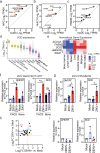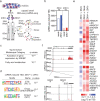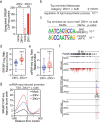SREBP2-dependent lipid gene transcription enhances the infection of human dendritic cells by Zika virus
- PMID: 36097162
- PMCID: PMC9465152
- DOI: 10.1038/s41467-022-33041-1
SREBP2-dependent lipid gene transcription enhances the infection of human dendritic cells by Zika virus
Abstract
The emergence of Zika virus (ZIKV) as a global health threat has highlighted the unmet need for ZIKV-specific vaccines and antiviral treatments. ZIKV infects dendritic cells (DC), which have pivotal functions in activating innate and adaptive antiviral responses; however, the mechanisms by which DC function is subverted to establish ZIKV infection are unclear. Here we develop a genomics profiling method that enables discrete analysis of ZIKV-infected versus neighboring, uninfected primary human DCs to increase the sensitivity and specificity with which ZIKV-modulated pathways can be identified. The results show that ZIKV infection specifically increases the expression of genes enriched for lipid metabolism-related functions. ZIKV infection also increases the recruitment of sterol regulatory element-binding protein (SREBP) transcription factors to lipid gene promoters, while pharmacologic inhibition or genetic silencing of SREBP2 suppresses ZIKV infection of DCs. Our data thus identify SREBP2-activated transcription as a mechanism for promoting ZIKV infection amenable to therapeutic targeting.
© 2022. The Author(s).
Conflict of interest statement
The authors declare no competing interests.
Figures





Similar articles
-
The novel therapeutic target and inhibitory effects of PF-429242 against Zika virus infection.Antiviral Res. 2021 Aug;192:105121. doi: 10.1016/j.antiviral.2021.105121. Epub 2021 Jun 24. Antiviral Res. 2021. PMID: 34175321
-
The Compound SBI-0090799 Inhibits Zika Virus Infection by Blocking De Novo Formation of the Membranous Replication Compartment.J Virol. 2021 Oct 27;95(22):e0099621. doi: 10.1128/JVI.00996-21. Epub 2021 Sep 1. J Virol. 2021. PMID: 34468177 Free PMC article.
-
Zika virus infection differentially affects genome-wide transcription in neuronal cells and myeloid dendritic cells.PLoS One. 2020 Apr 14;15(4):e0231049. doi: 10.1371/journal.pone.0231049. eCollection 2020. PLoS One. 2020. PMID: 32287277 Free PMC article.
-
Lipid Droplets and Their Participation in Zika Virus Infection.Int J Mol Sci. 2022 Oct 20;23(20):12584. doi: 10.3390/ijms232012584. Int J Mol Sci. 2022. PMID: 36293437 Free PMC article. Review.
-
Targeting Type I Interferon Induction and Signaling: How Zika Virus Escapes from Host Innate Immunity.Int J Biol Sci. 2023 Jun 4;19(10):3015-3028. doi: 10.7150/ijbs.83056. eCollection 2023. Int J Biol Sci. 2023. PMID: 37416780 Free PMC article. Review.
Cited by
-
Position-dependent function of human sequence-specific transcription factors.Nature. 2024 Jul;631(8022):891-898. doi: 10.1038/s41586-024-07662-z. Epub 2024 Jul 17. Nature. 2024. PMID: 39020164 Free PMC article.
-
Metabolic reprogramming and lipid droplets are involved in Zika virus replication in neural cells.J Neuroinflammation. 2023 Mar 8;20(1):61. doi: 10.1186/s12974-023-02736-7. J Neuroinflammation. 2023. PMID: 36882750 Free PMC article.
-
Hypercapnia Increases Influenza A Virus Infection of Bronchial Epithelial Cells by Augmenting Cellular Cholesterol via mTOR and Akt.Int J Mol Sci. 2025 Apr 26;26(9):4133. doi: 10.3390/ijms26094133. Int J Mol Sci. 2025. PMID: 40362373 Free PMC article.
-
Enhancers associated with unstable RNAs are rare in plants.bioRxiv [Preprint]. 2023 Sep 25:2023.09.25.559415. doi: 10.1101/2023.09.25.559415. bioRxiv. 2023. Update in: Nat Plants. 2024 Aug;10(8):1246-1257. doi: 10.1038/s41477-024-01741-9. PMID: 37808859 Free PMC article. Updated. Preprint.
-
Zika virus targets human trophoblast stem cells and prevents syncytialization in placental trophoblast organoids.Nat Commun. 2023 Sep 8;14(1):5541. doi: 10.1038/s41467-023-41158-0. Nat Commun. 2023. PMID: 37684223 Free PMC article.
References
Publication types
MeSH terms
Substances
Grants and funding
- R01 CA238662/CA/NCI NIH HHS/United States
- R01 NS106387/NS/NINDS NIH HHS/United States
- S10 OD026929/OD/NIH HHS/United States
- T32 GM145427/GM/NIGMS NIH HHS/United States
- R01 AI163188/AI/NIAID NIH HHS/United States
- R21 AI140063/AI/NIAID NIH HHS/United States
- R00 GM135515/GM/NIGMS NIH HHS/United States
- T32 GM008666/GM/NIGMS NIH HHS/United States
- R01 GM134366/GM/NIGMS NIH HHS/United States
- R01 NS103434/NS/NINDS NIH HHS/United States
- K99 GM135515/GM/NIGMS NIH HHS/United States
- R01 AI153500/AI/NIAID NIH HHS/United States
- K08 AI130381/AI/NIAID NIH HHS/United States
- R01 AI116813/AI/NIAID NIH HHS/United States
LinkOut - more resources
Full Text Sources
Medical
Molecular Biology Databases

